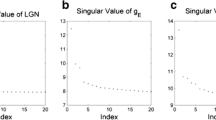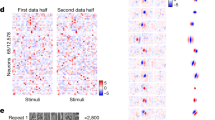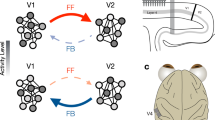Abstract
Systems-level neurophysiological data reveal coherent activity that is distributed across large regions of cortex. This activity is often thought of as an emergent property of recurrently connected networks. The fact that this activity is coherent means that populations of neurons may be thought of as the carriers of information, not individual neurons. Therefore, systems-level descriptions of functional activity in the network often find their simplest form as combinations of the underlying neuronal variables. In this paper, we provide a general framework for constructing low-dimensional dynamical systems that capture the essential systems-level information contained in large-scale networks of neurons. We demonstrate that these dimensionally-reduced models are capable of predicting the response to previously un-encountered input and that the coupling between systems-level variables can be used to reconstruct cellular-level functional connectivities. Furthermore, we show that these models may be constructed even in the absence of complete information about the underlying network.








Similar content being viewed by others
References
Akaike, H. (1974). A new look at the statistical model identification. IEEE Transactions on Automatic Control, 19, 716–723.
Antoulas, T. C. (2005). Approximation of large-scale dynamical systems. Philadelphia: SIAM.
Blasdel, G. G. (1992a). Differential imaging of ocular dominance and orientation selectivity in monkey striate cortex. Journal of Neuroscience, 12, 3115–3138.
Blasdel, G. G. (1992b). Orientation selectivity, preference, and continuity in monkey striate cortex. Journal of Neuroscience, 12, 3139–3161.
Bonhoeffer, T., & Grinvald, A. (1991). Iso-orientation domains in cat visual cortex are arranged in pinwheel-like patterns. Nature, 353, 429–431.
Bosking, W. H., Zhang, Y., Schofield, B., & Fitzpatrick, D. (1997). Orientation selectivity and the arrangement of horizontal connections in tree shrew striate cortex. Journal of Neuroscience, 17, 2112–2127.
Broder, J., Majumder, A., Porter, E., Srinivasamoorthy, G., Keith, C., Lauderdale, J., et al. (2007). Estimating weak ratiometric signals in imaging data. I. Dual-channel data. Journal of the Optical Society of America. A, Optics, image science, and vision, 24, 2921–2931.
Cai, D., Tao, L., Shelley, M., & McLaughlin, D. W. (2004). An effective kinetic representation of fluctuation-driven neuronal networks with application to simple and complex cells in visual cortex. Proceedings of the National Academy of Sciences of the United States of America, 101, 7757–7762.
Cai, D., Rangan, A. V., & McLaughlin, D. W. (2005). Architectural and synaptic mechanisms underlying coherent spontaneous activity in V1. Proceedings of the National Academy of Sciences of the United States of America, 102, 5868–5873.
De Valois, R. L., Albrecht, D. G., & Thorell, L. G. (1982). Spatial frequency selectivity of cells in macaque visual cortex. Vision Research, 22, 545–559.
Eckart, C., & Young, G. (1936). The approximation of one matrix by another of lower rank. Psychometrika, 1, 211–218.
Everson, R. M., Prashanth, A. K., Gabbay, M., Knight, B. W., Sirovich, L., & Kaplan, E. (1998). Representation of spatial frequency and orientation in the visual cortex. Proceedings of the National Academy of Sciences of the United States of America, 95, 8334–8338.
FitzHugh, R. (1961). Impulses and physiological states in theoretical models of nerve membrane. Biophysical Journal, 1, 445–466.
Hubel, D. H., & Wiesel, T. N. (1959). Receptive fields of single neurones in the cat’s striate cortex. Journal of Physiology, 148, 574–591.
Hubel, D. H., & Wiesel, T. N. (1962). Receptive fields, binocular interaction and functional architecture in the cat’s visual cortex. Journal of Physiology, 160, 106–154.
Hubel, D. H., & Wiesel, T. N. (1977). Ferrier lecture. Functional architecture of macaque monkey visual cortex. Proceedings of the Royal Society of London. Series B, Biological sciences, 198, 1–59.
Ikeda, S., & Toyama, K. (2000). Independent component analysis for noisy data—MEG data analysis. Neural Networks, 13, 1063–1074.
Jolivet, R., Lewis, T. J., & Gerstner, W. (2004). Generalized integrate-and-fire models of neuronal activity approximate spike trains of a detailed model to a high degree of accuracy. Journal of Neurophysiology, 92, 959–976.
Kistler, W., Gerstner, W., & Hemmen, J. L., van. (1997). Reduction of the Hogkin-Huxley equations to a single-variable threshold model. Neural Computation, 9, 1015–1045.
Knight, B. W., Omurtag, A., & Sirovich, L. (2000). The approach of a neuron population firing rate to a new equilibrium: an exact theoretical result. Neural Computation, 12, 1045–1055.
Lorenz, E. N. (1956). Empirical orthogonal functions and statistical weather prediction. In Scientific report. Cambridge, MA: Statistical Forecasting Project, MIT.
Lumley, J. L. (1967). The structure of inhomogeneous turbulent flows. In A. M. Yaglom & V. I. Tatrski (Eds.), Atmospheric turbulence and radio wave propagation. Moscow: Nauka.
Makeig, S., Bell, A. J., Jung, T.-P., & Sejnowski, T. J. (1996). Independent component analysis of electroencephalographic data. Advances in Neural Information Processing Systems, 8, 145–151.
McKeown, M. J., Jung, T. P., Makeig, S., Brown, G., Kindermann, S. S., Lee, T. W., et al. (1998). Spatially independent activity patterns in functional MRI data during the stroop color-naming task. Proceedings of the National Academy of Sciences of the United States of America, 95, 803–810.
McLaughlin, D., Shapley, R., Shelley, M., & Wielaard, D. J. (2000). A neuronal network model of macaque primary visual cortex (V1): orientation selectivity and dynamics in the input layer 4Calpha. Proceedings of the National Academy of Sciences of the United States of America, 97, 8087–8092.
Mitra, P. P., & Pesaran, B. (1999). Analysis of dynamic brain imaging data. Biophysical Journal, 76, 691–708.
Nagumo, J. S., Arimoto, S., & Yoshizawa, S. (1962). An active pulse transmission line simulating nerve axons. Proceedings of the IRE, 50, 2061–2070.
Nykamp, D. Q. (2005). Revealing pairwise coupling in linear-nonlinear networks. SIAM Journal on Applied Mathematics, 65, 2005–2032.
Nykamp, D. Q. (2007). A mathematical framework for inferring connectivity in probabilistic neuronal networks. Mathematical Biosciences, 205, 204–251.
Rangan, A. V., Cai, D., & McLaughlin, D. W. (2005). Modeling the spatiotemporal cortical activity associated with the line-motion illusion in primary visual cortex. Proceedings of the National Academy of Sciences of the United States of America, 102, 18793–18800.
Reid, R. C., & Alonso, J. M. (1995). Specificity of monosynaptic connections from thalamus to visual cortex. Nature, 378, 281–284.
Shelley, M., & McLaughlin, D. (2002). Coarse-grained reduction and analysis of a network model of cortical response: I. Drifting grating stimuli. Journal of Computational Neuroscience, 12, 97–122.
Sirovich, L. (1987). Turbulence and the dynamics of coherent structures, parts I-III. Quarterly of Applied Mathematics, 45, 561–590.
Sornborger, A., Sirovich, L., & Morley, G. (2003). Extraction of periodic multivariate signals: mapping of voltage-dependent dye fluorescence in the mouse heart. IEEE Transactions on Medical Imaging, 22, 1537–1549.
Sornborger, A., Yokoo, T., Delorme, A., Sailstad, C., & Sirovich, L. (2005). Extraction of the average and differential dynamical response in stimulus-locked experimental data. Journal of Neuroscience Methods, 141, 223–229.
Spitzer, H., & Hochstein, S. (1985). Simple—and complex-cell response dependences on stimulation parameters. Journal of Neurophysiology, 53, 1244–1265.
Tao, L., Shelley, M., McLaughlin, D., & Shapley, R. (2004). An egalitarian network model for the emergence of simple and complex cells in visual cortex. Proceedings of the National Academy of Sciences of the United States of America, 101, 366–371.
Tao, L., Cai, D., McLaughlin, D. W., Shelley, M. J., & Shapley, R. (2006). Orientation selectivity in visual cortex by fluctuation-controlled criticality. Proceedings of the National Academy of Sciences of the United States of America, 103, 12911–12916.
Wielaard, D. J., Shelley, M., McLaughlin, D., & Shapley, R. (2001). How simple cells are made in a nonlinear network model of the visual cortex. Journal of Neuroscience, 21, 5203–5211.
Xu, J., Sornborger, A. T., Lee, J. K., & Shen, P. (2008). Drosophila TRPA channel modulates sugar-stimulated neural excitation, avoidance and social response. Nature Neuroscience, 11, 676–682.
Acknowledgments
This work was supported by (ATS) NIH NIBIB005432 and (LT) NSF DMS-0506257. ATS would like to thank Liping Wei and the Center for Bioinformatics at the College of Life Sciences at Peking University for their hospitality. Most of the large-scale numerical computations were performed on the NJIT Hydra cluster obtained under NSF MRI-0420590.
Author information
Authors and Affiliations
Corresponding authors
Additional information
Action Editor: David Golomb
Electronic supplementary material
Below is the link to the electronic supplementary material.
Supplementary Movie 1
Comparison of network activity in a large-scale simulation driven by 16 orientations (left hand movie), and predictions by a DRM trained on all 16 orientations (middle movie) and by a DRM trained on only 8 orientations (right hand movie). (MOV 3049 kb)
Rights and permissions
About this article
Cite this article
Tao, L., Sornborger, A.T. Dimensionally-reduced visual cortical network model predicts network response and connects system- and cellular-level descriptions. J Comput Neurosci 28, 91–106 (2010). https://doi.org/10.1007/s10827-009-0189-8
Received:
Revised:
Accepted:
Published:
Issue Date:
DOI: https://doi.org/10.1007/s10827-009-0189-8




